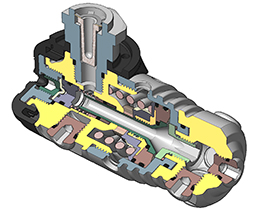First Stage TechnologyHomeDiving TechnologyFirst Stage TechnologyBalanced Piston
FIRST STAGES
The task of a first stage regulator is quite simple: reduce high
pressure air coming from the tank to a consistent intermediate
pressure. They are generally divided into PISTON and DIAPHRAGM
categories, depending on the mechanism used to control the valve,
allowing air to flow to the second stage. Due to their design and
their particular advantages, each of them have become the favorites
of different groups in the diving community. First stages can be
further classified between CLASSIC DOWNSTREAM and BALANCED,
affecting function and performance of the first stage related to
pressure changes in the tank.
THE PISTON TECHNOLOGY
The general advantage of a piston-based first stage lies
in its reliability and reduced maintenance requirements, due to an
effective but simpler mechanism with less moving parts. More
importantly, no other design can reach the high air delivery rate
of a balanced piston controlled first stage.
Air balanced flow-through piston
First stages with air balanced pistons deliver
significantly more air to the second stage than any other first
stage, while their performance is totally unaffected by the
changing tank pressure. A balanced piston allows the use of lighter
and more sensitive components, resulting in ultra fast breathing
response, instant delivery of air on demand and extra high air
flow, especially in low tank pressure ranges. The tired diver
benefits from of a smoother breathing regulator during the ascent
or deco stop. Balanced piston first stages are the first choice of
demanding sport divers and professionals. A balanced piston
performs equally in both warm and cold water environments. The
SCUBAPRO MK25 first stage uses this
technology.
Air balanced flow-through piston details
Classic downstream piston
This is the best example of bulletproof reliability and
trouble-free, minimal maintenance regulators. The conventional
downstream piston confi guration is the simplest mechanism that
exists to control the pressure drop from a tank to feed the 2nd
stage. The classic downstream valve is the first choice of diving
centers and rental facilities worldwide for warm and moderate water
temperatures. Our MK2 Plus features this
technology.

THE DIAPHRAGM TECHNOLOGY
Diaphragm-based first stages are environmentally
sealed so that water cannot enter the inner mechanism. Bearing in
mind that regulators generate temperatures up to minus 30 °C
due to the incredibly fast moving air and the high pressures
involved, it is imperative that sensitive moving metal parts avoid
contact with extremely cold water.
Therefore, diaphragm first stages have been the favored choice of
cold-water divers and those working in contaminated or muddy
water.
All our diaphragm first stages feature a balanced technology and
are packed with patented features resulting in ultra fast flow to
the second stage upon request and a fantastic overall
performance.
The balanced diaphragm technology provides
consistent performance at all cylinder pressures, at any depth
and optimises the second stage performance, thus allowing for
effortless breathing.
Our MK17 diaphragm first stage features a dry balancing chamber so that the water cannot enter the first stage, this means it's resistance to freezing is unmatched even in extremely cold waters.
Balanced diaphragm with dry chamber details
Our MK11 diaphragm first stage has the same structure as MK17 but without a dry chamber and it is the perfect choice for the recreational diver who wants the advantage of a diaphragm fisrt stage for use in temperate waters.
